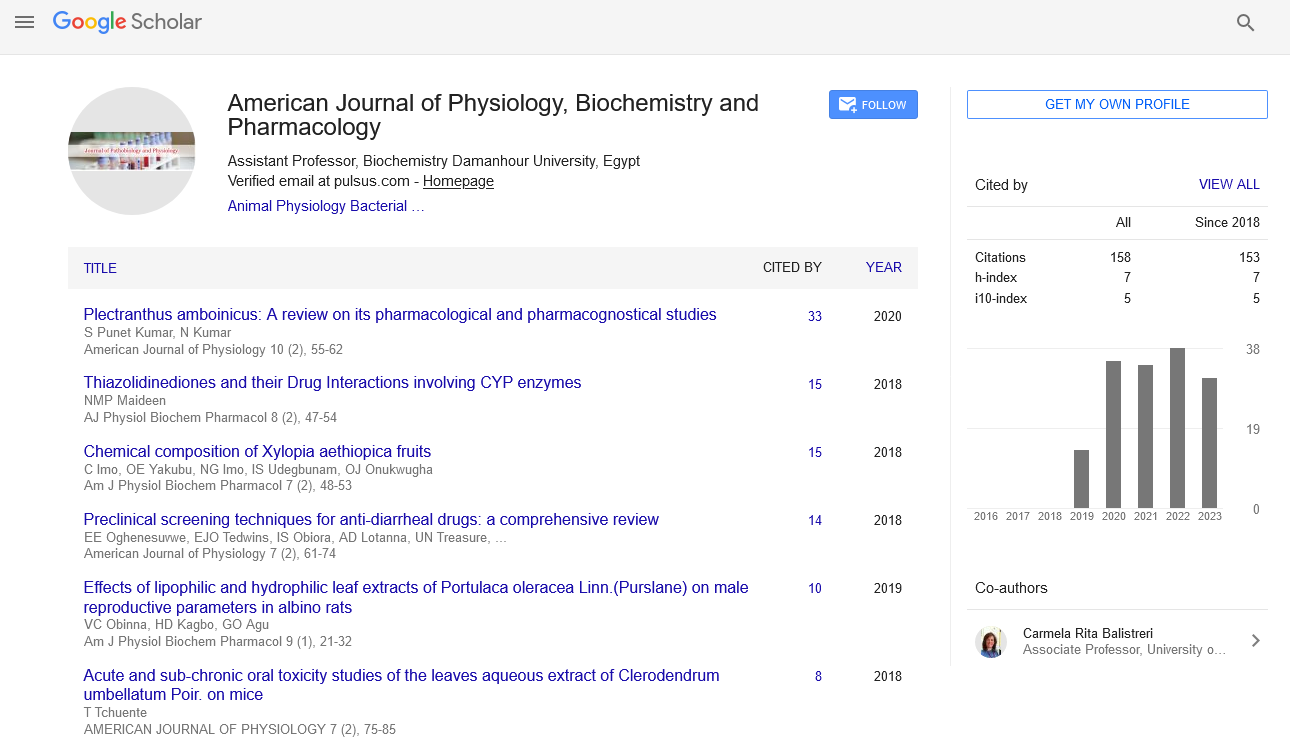Commentary - American Journal of Physiology, Biochemistry and Pharmacology (2022)
Hypothesis of Physiological and Pathophysiological Conditions
Natali Romero*Natali Romero, Department of Physiology, University of Haifa, Haifa, Israel, Email: nattali@gmail.com
Received: 20-Sep-2022, Manuscript No. AJPBP-22-74990; Editor assigned: 23-Sep-2022, Pre QC No. AJPBP-22-74990 (PQ); Reviewed: 07-Oct-2022, QC No. AJPBP-22-74990; Revised: 13-Oct-2022, Manuscript No. AJPBP-22-74990 (R); Published: 21-Oct-2022
Description
Physiology is a scientific study of processes and mechanisms of a living system. The objective is to describe the basic workings of biological systems and their interactions. Physiology is a branch of biology that focuses on how animals, organ systems, specific organs, cells, and biomolecules that perform the chemical and physical processes are necessary for a living system to function. The field can be separated into medical physiology, animal physiology, plant physiology, cell physiology, and comparative physiology in accordance with all types of organisms [1]. Biophysical and metabolic processes, homeostatic regulatory systems, and cell-to-cell communication are the essential for physiological function. While pathological state refers to aberrant situations, are especially human diseases, and physiological state is the condition of normal function.
Uncovering the changed biological by physical and chemical processes in our organism that precede, accompany, or follow specific ailments or diseases is the basic goal of the field of pathophysiology [2]. The study of the abnormal physiological processes that produce result from, or either connected with a damage, by which confluence of pathology and physiology. The biological discipline that defines the processes or mechanisms at work within an organism. Pathophysiology is tried to measure the level of stress hormones are such as corticosteroids in the blood and saliva, either in a resting state or after acute stress induction [3].
Pathology is the medical field that describes the circumstances that are generally seen during a disease. The study of disease by involving a variety of biological research areas and medicinal procedures. Types of pathogenesis are included by microbial infection, inflammation, malignancy and tissue breakdown. Pathophysiology attempts to explain the functional changes that are taking place within an individual as a result of a disease or pathologic state, whereas by pathology characterises the abnormal or undesirable condition [4]. Pathophysiology are included by three conductions are such as Etiology, Pathogenesis, Clinical manifestations. Etiology is refers to study of the proposed cause of a particular disease process are involved in epidemiology. It is common to distinguish between proximal, distal, necessary, and adequate causes. The identification of a disease’s or pathology’s aetiology is referred to as aetiology in medical terminology [5]. Its impact on human civilization can be attributed to a number of remarkable discoveries by including the germ hypothesis of pathology and the current understanding of the causes of diseases and also implementing to treat them.
Pathogenesis is the process by which a disease or disorder develops, the comprise elements that play a role in the development, progression, and maintenance of the ailment or disease as well as in its initiation. Pathogenic mechanisms of viral disease are included by implantation of virus at the portal of entry, local replication, spread to target organs, and spread to sites of shedding of virus into the environment. Manifest is a person has received or could reasonably have received a diagnosis of the disease, disorder, or pathological condition from a healthcare provider with the necessary education and experience in the relevant medical field. A clinical manifestation is the visible sign of a disease or condition [6]. All infections included in an AIDS-defining categorization are considered opportunistic infections linked to HIV.
References
- Lemoine M, Pradeu T. Dissecting the meanings of “Physiology” to assess the vitality of the discipline. Physiol. 2018; 33(4):236-45.
[Google Scholar] [Pubmed]
- Neill JD, Benos DJ. Relationship of molecular biology to integrative physiology. Physiol. 1993; 8(5):233-5.
- Carter KC. Germ theory, hysteria, and Freud's early work in psychopathology. Med Hist. 1980 ;24(3):259-74.
[Google Scholar] [Pubmed]
- Brown TM, Fee E. Walter Bradford Cannon: Pioneer physiologist of human emotions. American J Public Health. 2002;92(10):1594-5.
- Oparil S, Zaman MA, Calhoun DA. Pathogenesis of hypertension. Ann Intern Med. 2003;139(9):761-76.
- Kendell R, Jablensky A. Distinguishing between the validity and utility of psychiatric diagnoses. Am J Psychiatry. 2003;160(1):4-12.
[Crossref] [Google Scholar] [Pubmed]
Copyright: © 2022 The Authors. This is an open access article under the terms of the Creative Commons Attribution NonCommercial ShareAlike 4.0 (https://creativecommons.org/licenses/by-nc-sa/4.0/). This is an open access article distributed under the terms of the Creative Commons Attribution License, which permits unrestricted use, distribution, and reproduction in any medium, provided the original work is properly cited.






